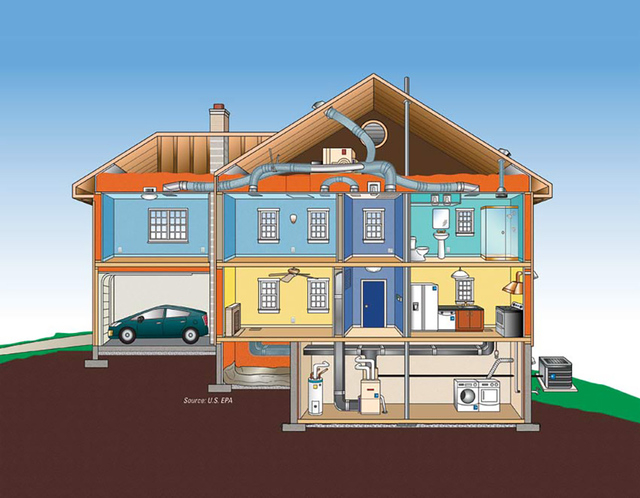Las Vegas homes built tighter with more energy-efficient features
Southern Nevada homebuilders face many challenges when building homes in the Mojave Desert.
Scarce water resources and blistering hot summers require special construction solutions that provide comfort and convenience to resident families but also conserve water, electricity and natural gas.
Green, energy-efficient homebuilding practices have survived the test of time after a devastating economic recession challenged local developers to find the most economic building techniques that would still continue to offer value to prospective homebuyers.
Most energy-efficient construction practices begin with the envelope surrounding the living space.
“Tight framing between stud boards is the first step to preventing leaks between the indoor and outdoor areas,” said Brandon Laughter, vice-president of construction for Pulte Homes. “There should be no gaps and a tight seal all around.”
The homebuilding team adds insulating foam to any potential leakage areas, especially window framing junctions. Blown-in cellulose insulation is used in the walls and the top part of the truss in the attic area, creating a “cathedralized” insulation pattern.
“The HVAC system is usually located in the attic, so insulating the inner roof surface above the attic space also affects the HVAC system air temperature,” said Wayne Newmiller, director of procurement for Pulte Homes.
Heating, ventilating and air-conditioning systems installed by Pulte have a SEER-15 rating with an option for a SEER-16 system. The Seasonal Energy Efficiency Ratio measures the cooling output of an HVAC system during its most demanding season and compares it to the amount of energy required to operate it.
Natural gas furnaces and heating systems within a home are also rated by an Annual Fuel Utilization Efficiency, or AFUE, that measures a ratio of useful energy output to energy input. Southwest Gas provides a rebate to homeowners who purchase furnaces rated with an AFUE of 92 percent or greater.
These heating systems produce 92 BTUs of heat for every 100 BTUs of natural gas energy consumed.
Zoned climate-control features and digital thermostats are also available as standard features, as well as enhanced options available to improve air quality throughout the house. Installing ceiling fans in high-occupancy rooms can use less electricity than HVAC systems to circulate the air.
Double-paned windows with low-emissivity glass and vinyl frames are installed in all new Pulte homes to provide additional protection from the sun. Low-E glass allows natural sunlight to penetrate the window surface and illuminate the home but blocks the heat radiated by ultraviolet and infrared rays.
Pulte Homes employs an in-house inspector to check each phase of construction for leakage and efficiency, including the use of a thermal imaging camera to check for insulation losses and a forced-air blower to test the effectiveness of air ducts and door seals.
Water, electricity and natural gas are conserved by choosing Energy Star appliances for laundry and dishwashing tasks.
Tankless water heaters are coupled with “home-run” plumbing systems in Pulte Homes to shorten the time and distance required for hot water to flow to shower heads and sink faucets.
Low-flow toilet fixtures can also conserve a family’s water usage; while desert landscapes and drip irrigation systems minimize water consumption in the outdoor living spaces.
Compact fluorescent lights and light-emitting diode fixtures have replaced incandescent bulbs in new homes because of their longer life and lower electricity consumption.
The choice of roofing materials also can save homeowners time and money over the life of their dwelling place.
“The rooftop material’s primary function is to protect the underlayment from rain and weather,” said Kyle Tibbitts, general manager at Shea Homes.
Decorative tile rooftops have been a popular and practical choice for Southern Nevada homebuilders.
The tile materials provide a strong surface that sheds water easily, does not rot, repels insects, allows for air circulation between the tile and rooftop and are also fire-resistant.
Homebuilders in Southern Nevada have learned to work with local utility providers and government agencies to leverage their incentive programs that promote energy efficiency.
Southwest Gas offers energy bill rebates for weatherization, Energy Star appliances, furnace installations with AFUE rating greater than 92 percent and solar water heating installations: www.swgas.com. NV Energy provides energy bill rebates for the use of LED lighting, energy-efficient swimming pool pumps and home energy management systems: www.nvenergy.com.
To find out more information about the federal government’s Energy Star program initiatives, visitwww.energystar.gov.
SILVER NUGGET WINNERS
GREEN BUILDER OF THE YEAR
• Pulte Group
DESIGN & ARCHITECTURE
• KB Home - Green Community
























